Did you know? Over 30 different genetic forms of Muscular Dystrophy have been identified, impacting people in diverse yet profound ways, while New Treatments for Muscular Dystrophy are in development to address these variations.
For many years, there was no cure for muscular dystrophy and treatment options were limited to managing symptoms.
However, recent advancements in medical research have led to the development of a new muscular dystrophy treatment that shows promising results.
Muscular dystrophy is a group of inherited disorders causing progressive muscle disease due to insufficient or absent glycoproteins in the muscle cell membrane.
In this blog, we aim to provide an overview of treatment options and their potential impact on those living with muscular dystrophy.
So, let’s dive in:-
What is Muscular Dystrophy?
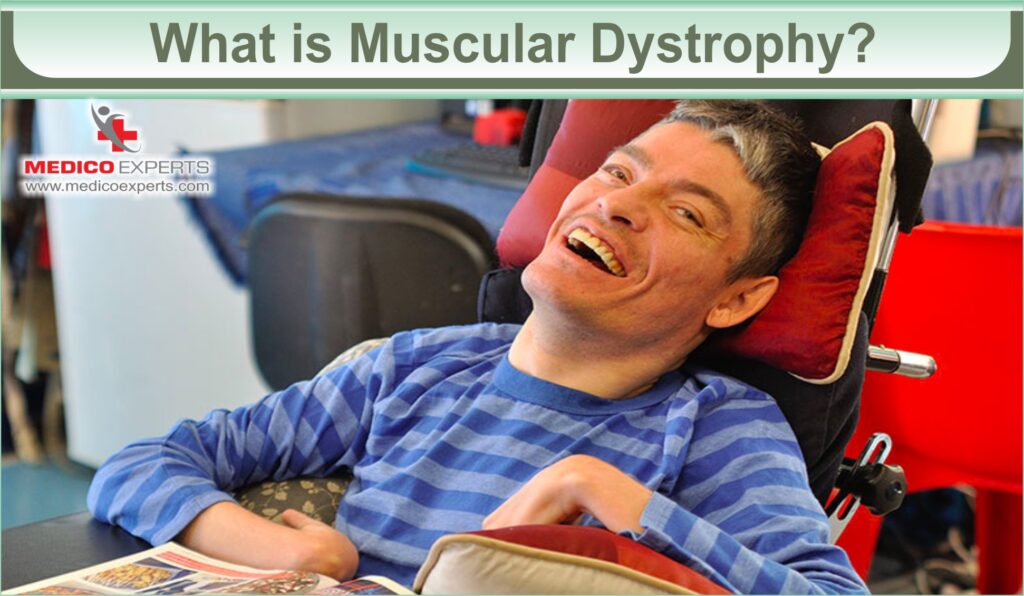
Muscular dystrophies are a diverse set of genetic conditions characterized by muscle weakness and a gradual loss of muscle mass.
This group of disorders affects different muscle groups in the body, leads to challenges in mobility, and varies in severity—from mild symptoms to severe physical disabilities.
While some types of muscular dystrophy are inherited, passing from one generation to the next, others may occur spontaneously in people with no family history of the condition.
Symptoms and the age at which they appear can differ significantly, even among patients with the same type of muscular dystrophy.
Despite their rarity, these conditions are the focus of ongoing research, including efforts by the Centers for Disease Control and Prevention (CDC) to better understand their prevalence.
What are Muscular Dystrophy’s common signs and symptoms?
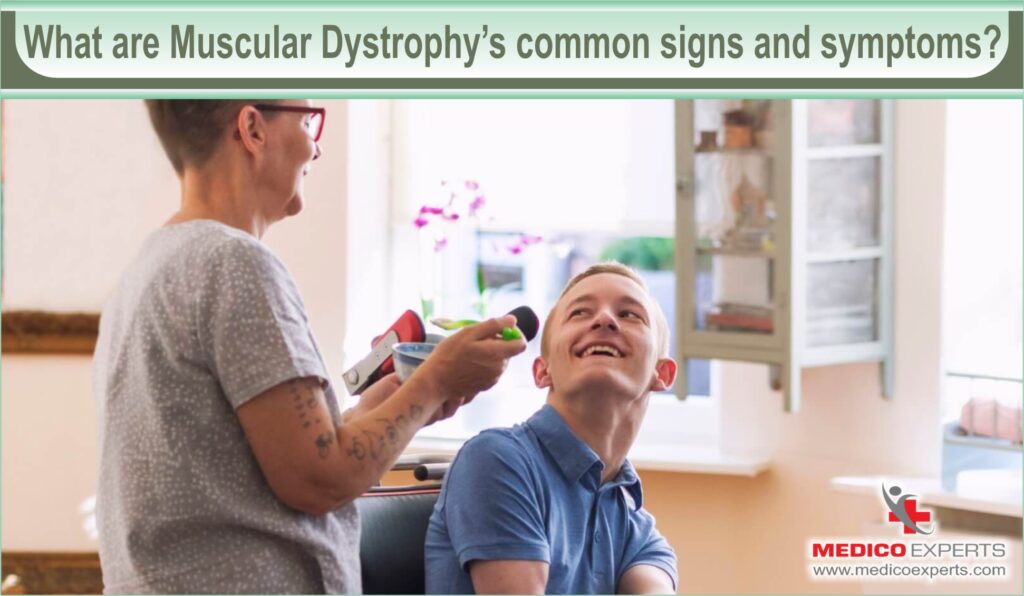
Muscular dystrophy typically manifests its symptoms during childhood or adolescence, affecting various aspects of a child’s physical abilities.
The doctor will ask about any signs and symptoms of MD you or your child have seen and when they started.
Here are some common indicators:
- Frequent falls
- Muscle weakness
- Muscle cramps
- Difficulty with activities such as standing up, climbing stairs, running, or jumping
- Toe walking or waddling gait
Additionally, some children may exhibit the following symptoms:
- Scoliosis (curvature of the spine)
- Ptosis (drooping eyelids)
- Cardiac issues
- Respiratory or swallowing difficulties
- Vision impairments
- Weakness in facial muscles
How is Muscular Dystrophy diagnosed?
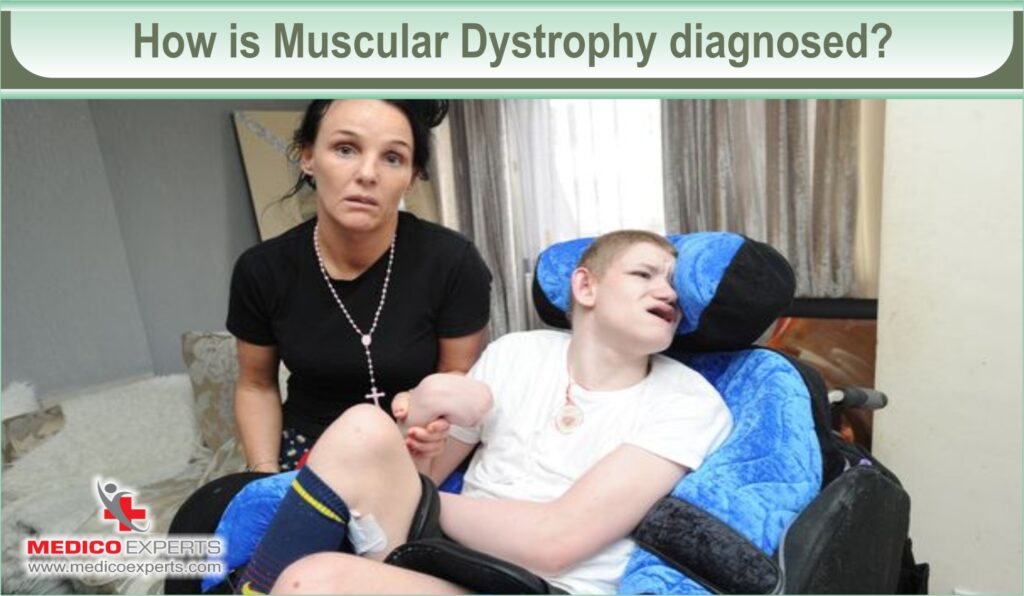
Diagnosing the various types of muscular dystrophy (MD) involves multiple methods. The age of diagnosis varies based on symptom onset.
The diagnostic process includes:
- Exploring presenting symptoms
- Reviewing the family history of MD
- Conducting a physical examination
- Performing different types of tests
If you experience symptoms like muscle weakness or mobility issues, consult a GP initially.
Further tests at a hospital may be recommended if needed.
Let’s see them in detail:
Exploring presenting symptoms
To diagnose MD types, it’s essential to know when your symptoms started and which muscles are involved. The details of different types of symptoms are discussed above.
Reviewing the family history of MD
Some types of muscular dystrophy have genetic origins.
Hence, if you are aware that a family member is affected by this disease, there may be an increased risk of it being passed down to the next generation.
Conducting a physical examination
This helps doctors assess muscle strength and look for signs like contractures—limited movements in joints due to muscle tightness.
The doctor may also check for muscle twitching or wasting away.
Performing different types of tests
Healthcare professionals may utilize various tests to diagnose MD accurately and determine the specific type present.
These tests also serve to rule out other potential causes of muscle weakness, such as injuries, toxic exposures, medications, or alternative muscle disorders.
Diagnostic procedures can include:
Diagnostic procedures are essential steps in the medical field. These procedures play a crucial role in guiding healthcare professionals toward accurate diagnoses, thereby facilitating effective treatment plans and patient care.
Let’s see them in detail:
Blood Tests
These tests measure levels of specific substances that may be elevated in individuals with MD, indicating muscle weakness, injury, or disease.
Key blood tests include:
- Serum creatine kinase: an enzyme released into the bloodstream due to muscle fiber damage.
- Serum aldolase: an enzyme aiding in sugar breakdown for energy.
- Myoglobin: a protein responsible for oxygen transportation and storage in muscles.
Muscle Biopsies
Involving the extraction of a small muscle tissue sample for microscopic examination, these biopsies help identify MD-specific markers.
Patients diagnosed through muscle biopsies often require genetic testing to confirm gene mutations.
Genetic Testing
This procedure identifies genes associated with inherited muscle diseases, confirming specific neuromuscular conditions, including MD.
Neurological tests:
Conducted to exclude nervous system disorders, and assess muscle weakness patterns, reflexes, coordination, and contractions.
Heart Assessments
Electrocardiograms (ECG) or echocardiograms (Echo) may be performed to evaluate heart rate, rhythm, and structure, especially in MD cases affecting heart function.
Exercise Evaluations
These assessments measure muscle strength, breathing capacity, and specific markers following physical activity.
Imaging Studies
Magnetic resonance imaging (MRI) and ultrasound imaging are valuable tools for analyzing internal body structures, muscle quality, bulk, and fat infiltration within muscle tissue.
Understanding the diagnosis of muscular dystrophy can be a significant emotional and mental challenge for patients and their families. Beyond the technical procedures and terms lies a personal journey characterized by uncertainty and resilience.
Empowering yourself with knowledge about the condition, and engaging with medical professionals and support networks can transform the diagnosis from an intimidating challenge into a manageable aspect of health.
Learn more about the causes of muscular dystrophy here.
What are the Conventional Treatments for Muscular Dystrophy?
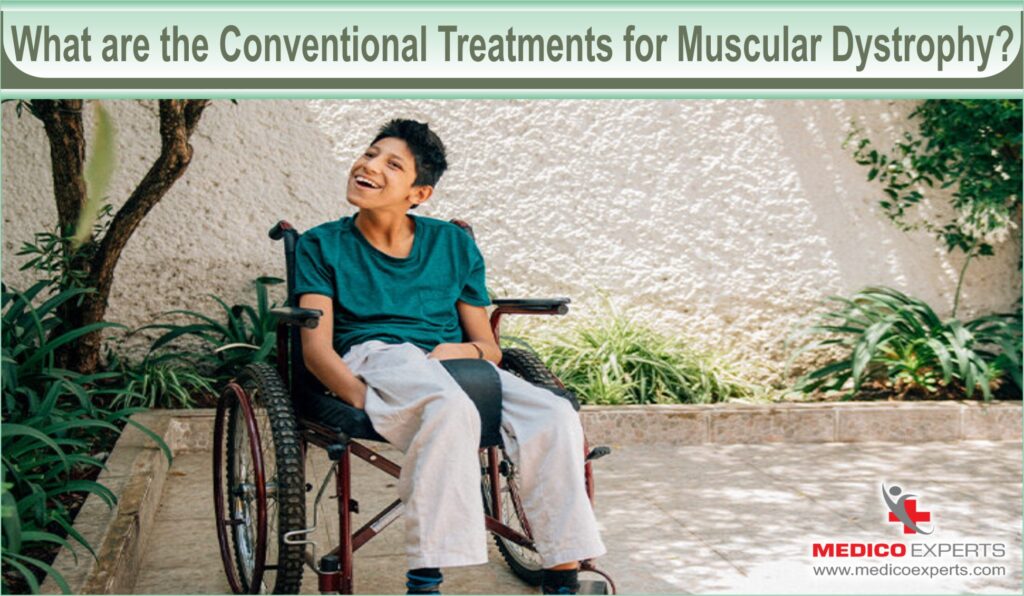
Treatment for muscular dystrophy (MD) focuses on symptom management, delaying the progression of muscle degeneration, and enhancing health.
Given the complexity and variability of MD, treatments are tailored to the specific needs of each individual, often requiring a multidisciplinary approach.
Here’s an overview of the primary treatments available:
Physical Therapy:
Physical therapy is a centerpiece in the management of MD, aimed at maintaining muscle function and flexibility.
- Stretching exercises are crucial for keeping muscles and joints flexible, and preventing contractures.
- Strength training can help maintain muscle strength without overexertion, which may worsen muscle damage.
- Aerobic exercise improves overall cardiovascular health without putting undue stress on the muscles.
- Assistive devices, like braces or wheelchairs, are often introduced to enhance mobility and independence.
Occupational Therapy:
Occupational therapy is focused on empowering individuals with MD to perform day-to-day activities with greater ease.
Through the adaptation of tasks and environments, occupational therapists work to improve the quality of life and foster autonomy.
Speech Therapy:
For those affected by MD in ways that impair their ability to speak or swallow, speech therapy offers a symbol of expectancy.
Speech therapists (or speech-language pathologists) provide specialized exercises and strategies to enhance speech clarity and safe swallowing techniques.
Psychological Support:
Facing MD can be challenging, not just physically but also emotionally. Access to mental health professionals, support groups, and counseling services provides essential emotional support for both patients and their families.
These resources can help individuals cope with the diagnosis and the challenges that come with managing a chronic condition.
Medication:
Several medications can help manage symptoms or slow the progression of the disease.
- Corticosteroids, such as prednisolone, can help increase muscle strength and slow progression, but long-term use can have significant side effects.
- Heart medications, including ACE inhibitors or beta-blockers, are prescribed if MD affects the heart.
- Immunosuppressants may be used in some cases to delay some aspects of muscle damage.
- New genetic therapies, such as exon skipping or gene replacement, are emerging treatments aiming to address the underlying genetic causes of some types of MD.
Surgical Treatments:
In some cases, surgery may be necessary to manage the complications of MD.
- Scoliosis surgery can correct or stabilize spinal curvature, improving posture and breathing.
- Tendon release surgery is performed to improve mobility and manage contractures.
- Cardiac surgery might be required for individuals with MD-related heart conditions, to implant devices that help manage heart rhythm disorders.
Nutritional Management:
Proper nutrition plays a pivotal role in managing MD.
- Dietary adjustments can help manage weight, as obesity can exacerbate mobility and respiratory issues.
- Nutritional supplements may be recommended to ensure adequate intake of certain vitamins and minerals that could benefit muscle health.
Respiratory Care:
Since MD can affect respiratory muscles, regular assessments and interventions are crucial.
- Breathing exercises help maintain lung capacity and strength.
- Assistive devices such as ventilators or BiPAP machines may be used during sleep or progressively throughout the day to support breathing.
What Are The New Muscular Dystrophy Treatment Options?
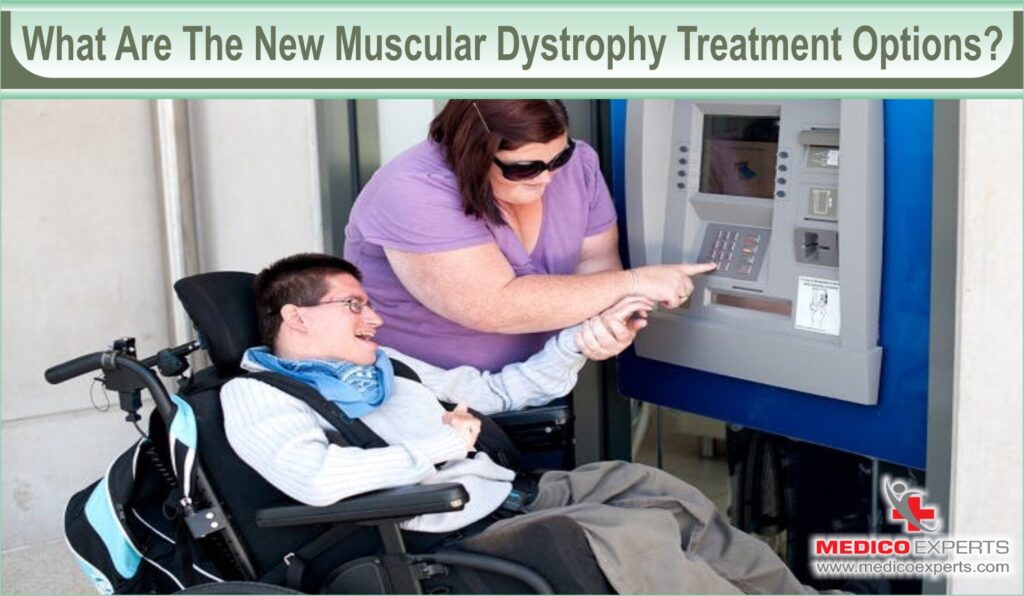
Currently, there is no cure for muscular dystrophy. However, researchers are constantly working on new treatments to help manage the symptoms and slow the progression of MD.
Some promising treatment options being studied include:
Gene therapy:
Gene therapy holds great promise as a revolutionary approach to treating Muscular Dystrophy (MD). This innovative treatment strategy involves introducing a correct version of the mutated gene that causes MD directly into a patient’s muscle cells.
The primary goal is to enable these cells to produce the protein that was either missing or defective due to the genetic mutation, thereby correcting the root cause of the disease.
Several methods are being explored to deliver these healthy genes, including viral vectors, which are modified viruses designed to carry the therapeutic gene into the muscle cells without causing disease themselves.
Another exciting aspect of gene therapy research focuses on CRISPR/Cas9 technology, a kind of molecular scissors that allows scientists to edit genes precisely at specific locations.
By targeting the specific mutations that cause MD, researchers hope to repair or replace the faulty genes, potentially restoring normal muscle function to affected individuals.
Stem cell therapy:
Stem cell therapy is another promising treatment for MD. Stem cells are specialized cells that can develop into different types of cells, including muscle cells.
The concept behind stem cell therapy for muscular dystrophy (MD) is both innovative and hopeful. Stem cells, by their unique ability to differentiate into various cell types, offer a potential pathway to regenerate or repair damaged muscle tissue characteristic of MD.
The process involves harvesting stem cells, which could be either from the patient (autologous transplantation) or a donor (allogeneic transplantation), and then treating them in a laboratory setting to enhance their muscle-regeneration capabilities. Following this preparation, these cells are reintroduced into the patient’s body, targeting the muscle areas most affected by MD.
Researchers are optimistic that once inside the body, these stem cells will engraft within the muscle tissue and begin the process of repairing or regenerating muscle cells thereby restoring some level of muscle function and strength that the disease has compromised.
Exon skipping:
Exon Skipping is a cutting-edge approach that targets the genetic mutations responsible for causing certain types of muscular dystrophy, particularly Duchenne Muscular Dystrophy (DMD).
This method works by manipulating the cell’s machinery to “skip over” faulty sections of the gene, known as exons that cause disruptions in the production of the dystrophin protein crucial for muscle health.
Through the use of synthetic molecules called antisense oligonucleotides (AONs), exon skipping can facilitate the production of a shorter albeit partially functional dystrophin protein.
This has the potential to slow the progression of the disease and improve the quality of life for those affected.
Clinical trials have shown promising results, indicating that exon-skipping therapy can lead to modest improvements in muscle function for some patients.
While not a cure, this strategy represents a significant step forward in muscular dystrophy treatment offering longing for more effective therapies in the future.
Anti-inflammatory medications:
Inflammation is a key process in the progression of MD, causing muscle damage and weakness. As such, researchers are exploring the use of anti-inflammatory medications to help manage symptoms and slow down disease progression.
Some promising drugs being studied include glucocorticoids, which can reduce inflammation and improve muscle strength in some types of MD.
Other potential treatments being investigated include TNF-alpha inhibitors and IL-6 blockers, which could help reduce inflammation in muscles and improve muscle function.
Clinical Trials and Research:
The relentless pursuit of advancements in Muscular Dystrophy (MD) treatment is heartening. These meticulously designed studies not only test the efficacy and safety of emerging treatments but also deepen our understanding of MD’s complexities.
Participation in clinical trials empowers patients and families, placing them at the forefront of medical innovation.
By volunteering people can contribute significantly to the collective effort to discover new treatments paving the way for future generations.
The Path Forward
While the pursuit of a cure continues, the advancements in treatment options and supportive care underscore a hopeful trajectory in the battle against Muscular Dystrophy.
As we look to the future, the synergy between pioneering treatments and supportive therapies promises to transform the landscape of Muscular Dystrophy care.
It is through persistent research, collaboration, and compassionate support that we inch closer to a world where the impact of MD is significantly lessened.
Meanwhile, MedicoExpert’s Team stands ready to provide critical assistance for navigating the complexities of Muscular Dystrophy (MD).
With a deep understanding of MD’s challenges and an empathetic approach, our dedicated team offers comprehensive support from providing up-to-date information on treatment options and clinical trials to facilitating access to the best care.
Recognizing that each patient’s journey is unique, we tailor our services to meet your specific needs, ensuring you have the necessary resources to make informed decisions about your health.
Connect with us today to take the first step in managing Muscular Dystrophy. We are dedicated to providing unwavering support and empowering you throughout your journey.
Frequently Asked Questions (FAQs)
Q1. How does muscular dystrophy affect children?
A. Muscular dystrophy (MD) in children often results in progressive muscle weakness and degeneration, affecting their ability to perform common physical activities like walking, running, and eventually, tasks requiring finer motor skills. Symptoms and progression can vary widely depending on the type of MD.
Q2. How long do muscular dystrophy patients live?
A. The life expectancy of individuals with muscular dystrophy varies significantly between the different types of MD. Some forms, such as Duchenne Muscular Dystrophy (DMD), are more severe and may lead to a shorter lifespan, often into the late twenties to early thirties, primarily due to respiratory or cardiac complications. Other forms, like Becker Muscular Dystrophy, allow individuals to live well into mid to late adulthood.
Q3. How painful is muscular dystrophy?
A. Muscular dystrophy itself is not always directly painful, but muscle weakness can lead to secondary conditions that cause discomfort or pain, such as joint deformities, muscle cramps, and back pain. Management and therapeutic strategies can help alleviate most of these painful symptoms.
Q4. What happens if muscular dystrophy is not treated?
A. Untreated muscular dystrophy leads to progressive muscle weakness and degradation, severely impacting mobility and daily activities. Over time, it can lead to complications such as respiratory failure, cardiac issues, and significantly reduced overall health.
Q5. Can muscular dystrophy be detected before symptoms appear?
A. Yes, muscular dystrophy can sometimes be detected before symptoms appear through genetic testing, especially if there’s a known family history of the disease. Prenatal testing and carrier screening are available for some forms of MD, which can inform potential parents about their risk of having a child with MD. At MedicoExpert, we bridge the gap between uncertainties and solutions, providing expert-led guidance and support tailored specifically to your Muscular Dystrophy challenges.
Q6. Is there any research towards finding a cure for muscular dystrophy?
A. Absolutely. Continuous research is dedicated to finding a cure for muscular dystrophy, focusing on gene therapy, stem cell therapy, and novel pharmaceuticals. Significant progress has been made in understanding the genetic and molecular bases of MD, leading to innovative treatments that aim to slow progression, manage symptoms, and ultimately, discover a cure.
References:-
https://www.ncbi.nlm.nih.gov/books/NBK560582/
https://www.ncbi.nlm.nih.gov/books/NBK560582/
https://www.ninds.nih.gov/health-information/disorders/muscular-dystrophy
https://www.ninds.nih.gov/health-information/disorders/muscular-dystrophy
https://www.fda.gov/news-events/press-announcements/fda-approves-first-gene-therapy-treatment-certain-patients-duchenne-muscular-dystrophy
https://www.ncbi.nlm.nih.gov/pmc/articles/PMC4480531/
https://www.ncbi.nlm.nih.gov/pmc/articles/PMC8673534/
https://www.researchgate.net/publication/230589000_Inflammation_in_muscular_dystrophy_and_the_beneficial_effects_of_non-steroidal_anti-inflammatory_drugs
https://www.ncbi.nlm.nih.gov/pmc/articles/PMC3886293/



